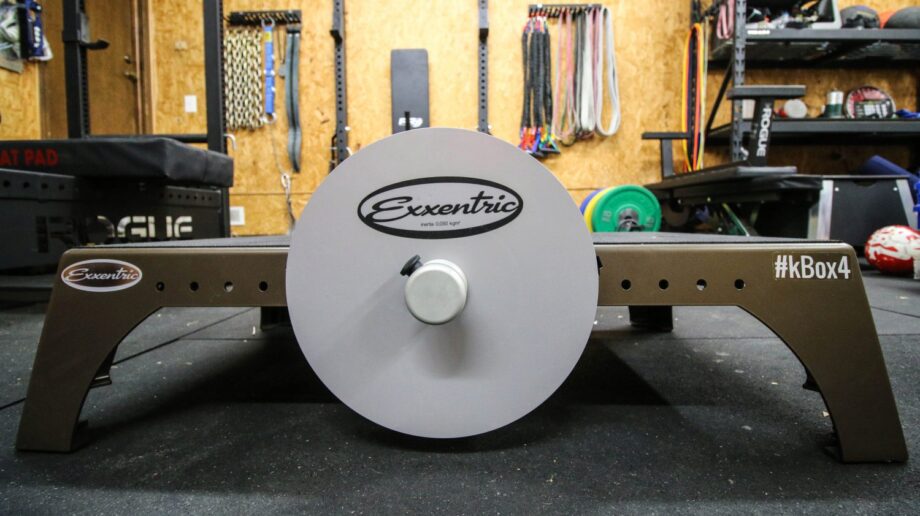We test and review fitness products based on an independent, multi-point methodology. If you use our links to purchase something, we may earn a commission. Read our disclosures.
The kBox4 from Exxentric is a revolutionary piece of training equipment that is unlike anything we’ve tested before. Not only is the flywheel system employed by the kBox4 effective, but the build quality and precision of the machine is unparalleled.
Exxentric
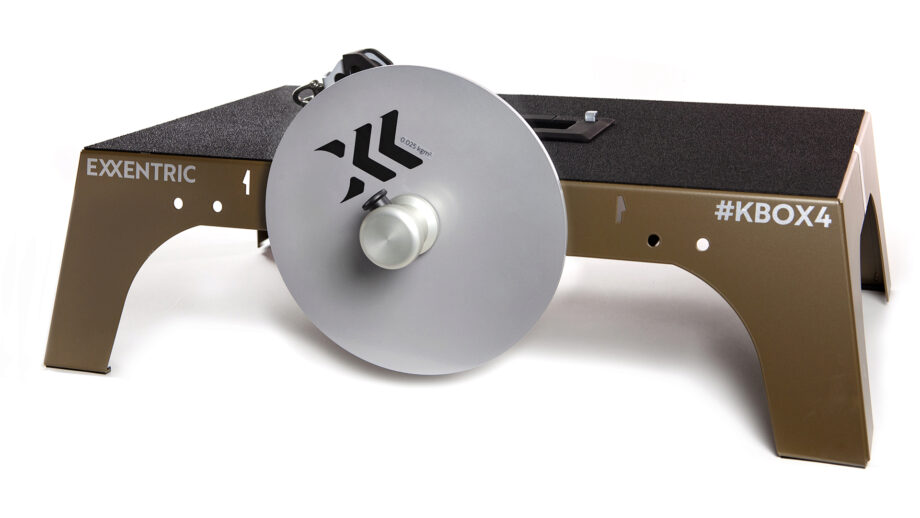
The kBox4 Pro is set apart by its market leading maximum inertia, built-in kMeter II feedback system and larger surface area, loved by strength and conditioning coaches as well as physiotherapists and top level personal trainers.The kBox4 Pro Platform is made in Sweden from powder-coated aluminium, with details made of anodized hardened carbon steel and aluminium, and high-friction rubber. This model has a CE-marking Certificate as a Medical Device. The kBox4 Pro can simultaneously hold four Flywheels of up to 0.070 kgm² each, with the maximum inertia level being 0.280 kgm².With the kBox and kPulley, instead of a fixed load determined by gravity when lifting weights, you work against the variable inertia of heavy steel flywheels determined by the effort and energy you unleash into the device.These training devices are truly versatile and serve multiple purposes, allowing you to engage your upper body, core and lower body with a wide variety of exercises.The kBox is renowned for its genial application of eccentric overload in regular training as well as its variable resistance, both backed by growing scientific support.
What is flywheel training?
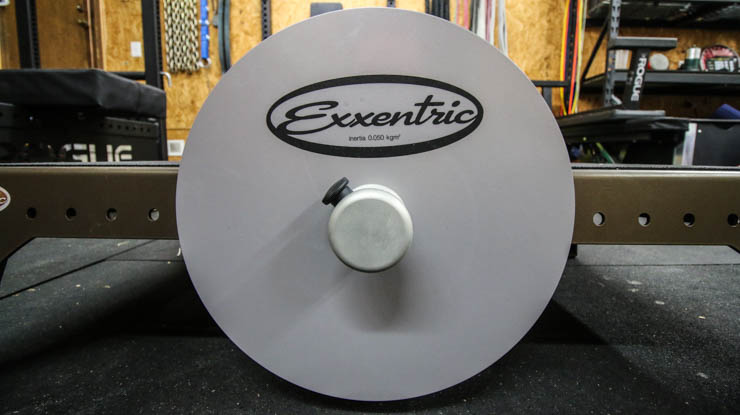
Many reading this have likely never heard of flywheel training, due to its still somewhat underground popularity. Trainers, coaches, and athletes the world over are utilizing flywheel training as a means for producing stronger, faster, and better performances. Although flywheel training is just now extending beyond the walls of people in the trenches (performance centers), I suspect that flywheel training will become ubiquitous within the coming decade.
To describe flywheel training in technical terms, a user attaches one or more flywheels (metal discs in the case of the Exxentric kBox4) to the end of a shaft/axle. In the middle of the shaft/axle, a cord is affixed that includes a carabiner type connecting piece that is then affixed to various attachments like a handle or body harness. The user then does various movements that utilize the inertia of the flywheels as resistance.
To describe flywheel training in street terms, an athlete jumps on a platform, attaches a harness to a spinning axle, and proceeds to hang on for dear life while a spinning ring of death attempts to cause greater DOMS (delayed onset muscle soreness) than they’ve ever experienced. To put it simply, flywheel training is brutal in terms of potential difficulty, unlimited in versatility, and powerful in its effectiveness.
The beauty of flywheel training is that the potential load is absolutely unlimited. I say ‘potential load’ because it’s all based on how much acceleration the user has in pulling or pushing away from the flywheel base. The harder you pull, the harder the flywheels want to pull you back. All of the energy you put into the flywheels during the concentric phase, will be used against you in the eccentric phase as you strive to brake the flywheels. If there were no bumper or object preventing you from going through the floor, the flywheels would literally rip your body around the axle in the same way it does the cord.
Flywheel training is also incredibly versatile. You can go from a squat to a curl in seconds without ever having to lift more than a couple of pounds to interchange the flywheel discs. Flywheel training is beautiful in its simplicity but worth utilizing in its effectiveness. Multiple studies, including this one, have found Flywheel training to be just as effective if not more in terms strength, power, hypertrophy, vertical jump height, and running speed.
Video Review

Unboxing
The Exxentric kBox4 showed up on my doorstep much quicker than expected, especially considering it was sent from overseas.
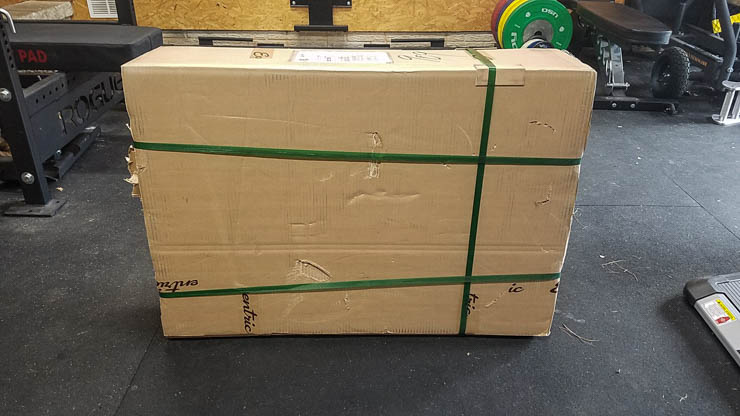
A piece of equipment with this price tag deserves to have heavy-duty packaging and thankfully it does. The outside of the box experienced a few scrapes as is expected with most parcel deliveries, but everything on the inside was in great shape.
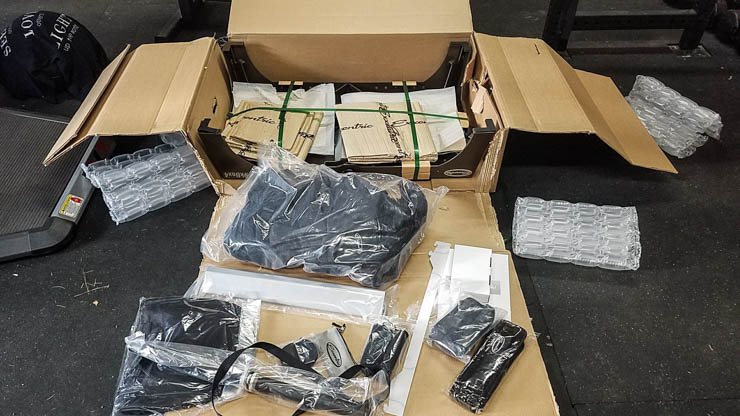
Upon opening the box, I found an array of attachments, flywheels, and the kBox platform. Due to the versatility of the kBox4, there are many attachments available to extend the usability of the device. Everything from handles to squat harnesses can be connected to the kBox that allows a wide variety of exercises. After a few minutes of cutting and unwrapping, the kBox4 was ready for use.
Exxentric kBox4 Review
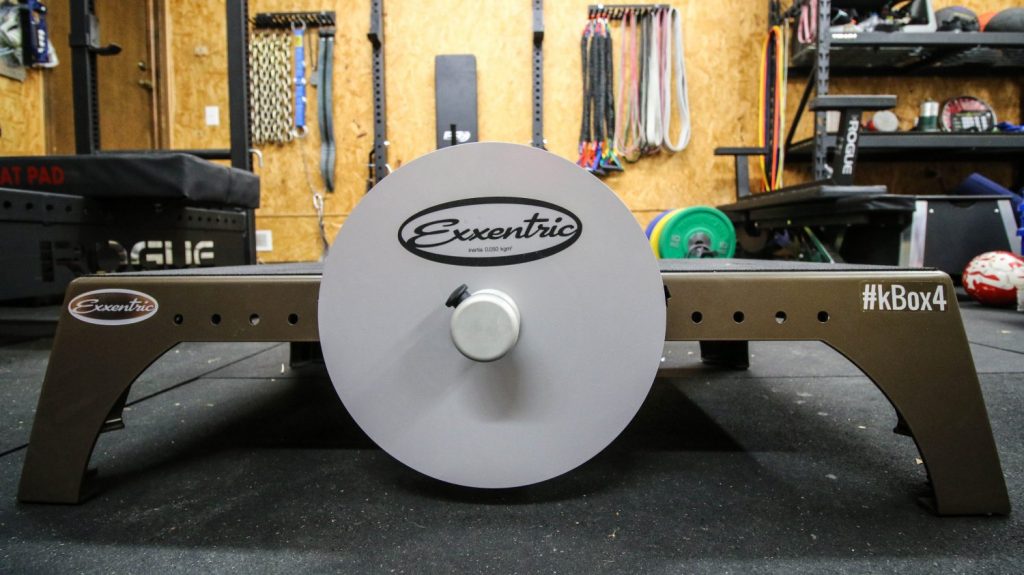
The Exxentric kBox4 is unlike any piece of equipment I’ve ever used. I’ve heard of flywheel training for some time, but due to their lack of popularity in the US (up until now) I’ve been unable to find one to use. Thankfully, after speaking with Exxentric, they decided to send us one to test and review.
Before I get into the performance aspects of the kBox4, I’d first like to discuss its build quality. Exxentric specializes in one main product, and that is this, the kBox4. When a company puts all of their time, energy, and creativity into a small product line, that both allows and forces them to make them the best they can be. We see this in the conditioning world with Concept 2 and their rower, which has now extended to the SkiERG and the BikeErg. We saw this in the technology world with Apple who sought to make the best desktops and is now the leader in innovation in just about everything computer related.
This laser-focus on creating the best possible flywheel training system is what makes the kBox4 so special. Yes, there are other companies making flywheel training devices, but Exxentric is on the forefront due largely to what I’ve just illustrated, a focus on making the kBox4 the best it can be.
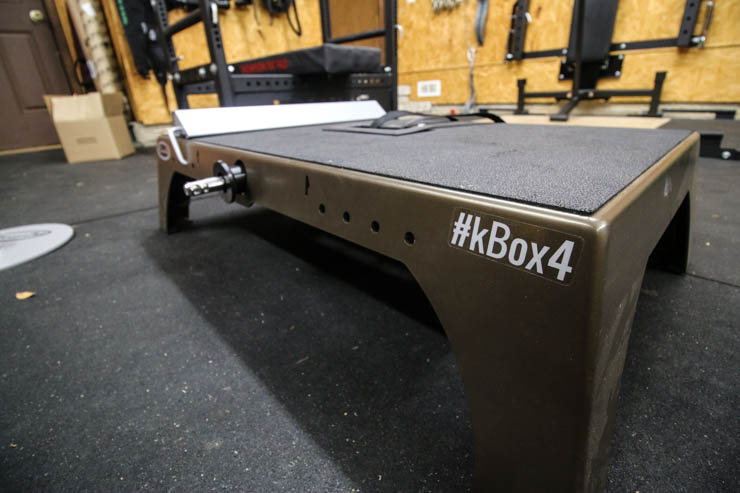
The build quality of the kBox4 is what you’d expect from a piece of equipment in this price range. When something is made for commercial use, including professional athletes who live and die by the power and athleticism they produce, it’s important that the piece of equipment being used can take a beating.
The largest piece of the kBox4 is the frame in which practically all of the work is done while being stood on. Every person who’s been seriously training for any period of time knows the importance of a solid base. It’s the reason Olympic Weightlifting shoes are so popular and have become such an integral part of not only the classic lifts, but also people who want a firm platform for squatting. In the same way, a pair of weightlifting shoes provide a solid base, the platform of the kBox4 does the same.
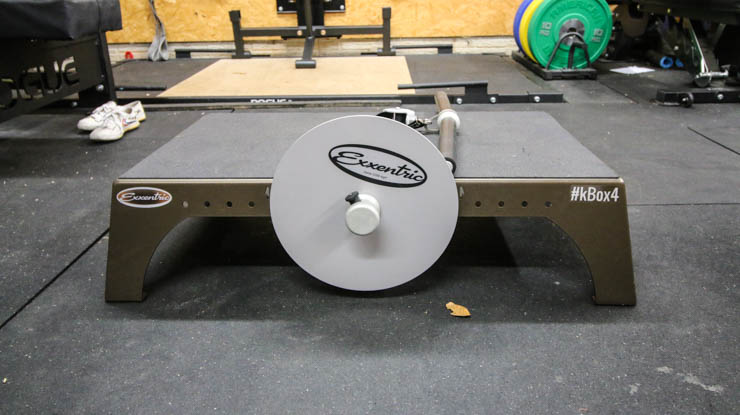
Using a single piece of thick-gauge aluminum, the platform on the kBox4 is made to handle athletes, no matter their size or power without any need for adjustment or maintenance. This is one feature of the kBox4 that in my research separates it from some other flywheel systems. When training athletes or yourself, you don’t want to have to mess with all of these different adjustments and required maintenance, you want to get on the equipment and get the work in so time can be spent elsewhere. The platform of the kBox4 isn’t going to flex or warp under your feet and it’s light enough to be moved by one person.
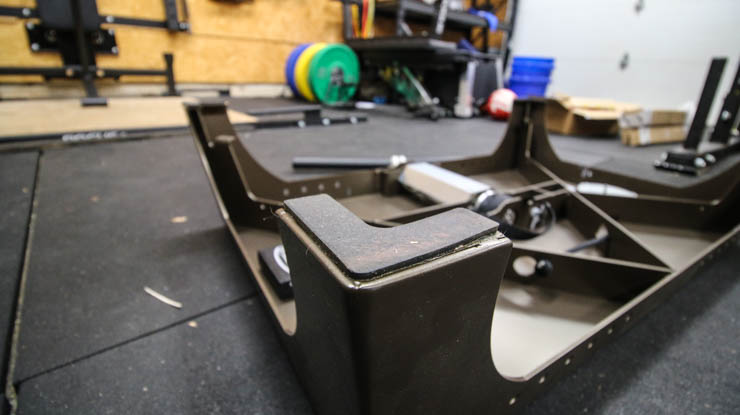
Although I’m a big fan of the design and function of the platform, there is one improvement in this area that I’d like to see. Attached to the bottom of the four corners of the platform are rubber, non-slip grip pads. These are great for people training on slick surfaces, but due to the platform’s rigidity and exactness, when the kBox4 is placed on a surface that isn’t perfectly flat, the platform tends to rock.
If you’ve ever been to a restaurant and sat at a table with one leg shorter than the other, you’ve likely experienced the rocking I’m referring to. Other pieces of equipment like the Schwinn AD Pro and Concept 2 BikeErg use adjustable feet that allow the machine to adjust for inconsistencies in the floor, and I feel this could benefit the kBox4. Thankfully, my floor is rather flat, so I didn’t experience this issue, but when I took it to other surfaces to test I did. This is a minor issue, but something I know could make the machine better.
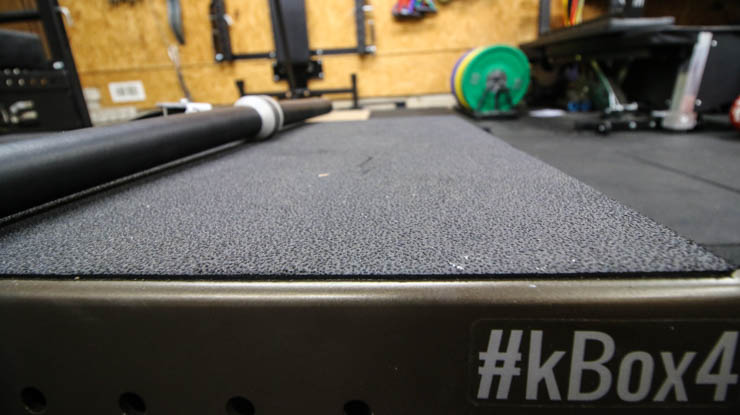
The top of the Exxentric kBox4 platform features a thin sheet of rubber that keeps your feet from slipping, and although there were a couple of air bubbles in between the adhesive and metal of the platform at first, they have all gone away. This piece of rubber is essential to keeping a solid grip, and I’m curious to see how it wear over time. In my two months of using the machine, it shows very little wear, so I hope it continues to be hard-wearing.
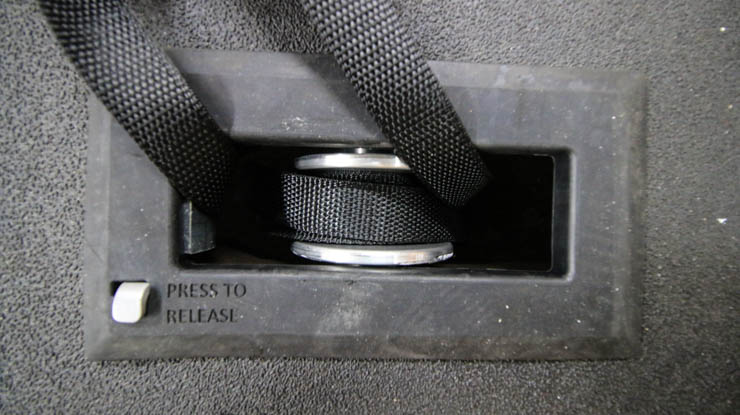
In the middle of the platform is a rectangular cutout that features a rubber bumper around the perimeter. This piece of rubber is imperative to keep the shaft from pulling you through the floor, and although it’s a small touch, it’s very important.
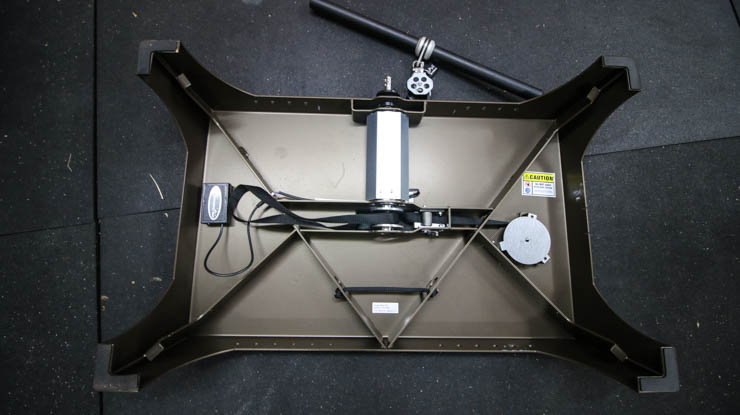
On the underside of the platform is where you see what makes the kBox4 what it is. The most impressive part of the kBox4 outside of its performance aspects is just how simple it is. This is the type of equipment that could be made incredibly too complicated, but when it comes to equipment and just about anything for that matter, I like to employ this famous quote from Einstein, “Everything should be made as simple as possible, but not simpler.”
The kBox4 exudes simplicity. Not in a manner that shows cut corners, but one in which nothing that shouldn’t be there, is there.
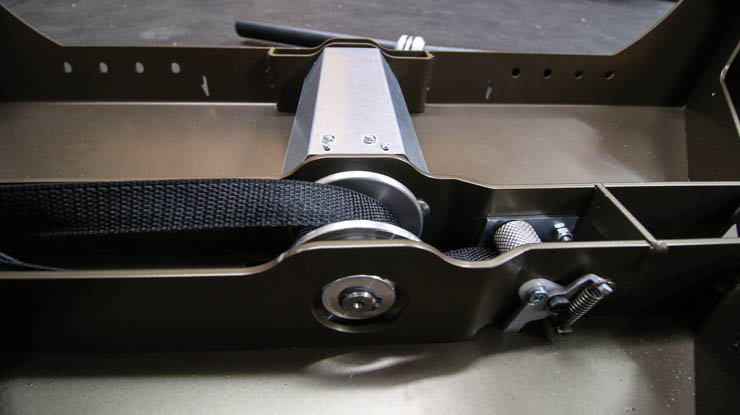
The flywheels on the kBox4 are attached to a shaft that runs all the way from the front of the machine to the back. In the middle of the platform, where the rectangle is cut, is where the nylon strap, known as the drive belt, that is attached to whatever accessory is being used is connected to the shaft. As the flywheels and shaft spin, they wrap the drive belt around the shaft, which then requires, in the case of the squat, for the user to explode out of the bottom. However, the faster the user pulls away from the shaft, the faster it will attempt to pull back (more on this in a moment.)
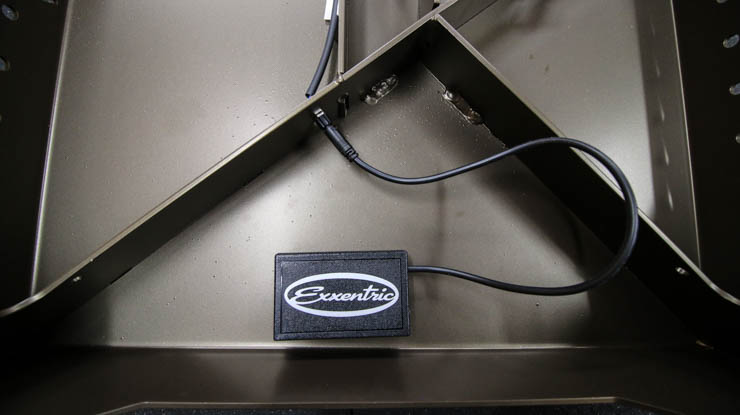
Also attached to the bottom of the platform is the connector for the optional kMeter Module. For anyone desiring metrics on measuring power and energy, then the kMeter is essential. The kMeter Module connects to the bottom of the kBox4 and then through Bluetooth connects to the app on your phone. The module measures the rotation of the flywheel and delivers various metrics on power, range of motion, eccentric load, and force.
For someone who doesn’t stress over these various metrics, I don’t see the module being needed. However, if you’re training others and want to be able to push them and show improvements in their performances, then the module is absolutely needed. With static weight, a 405 lb back squat obviously requires more strength than a 315 lb back squat. However, due to the various factors at play while using the kBox4, improvements are harder to judge. This is where the module comes in.
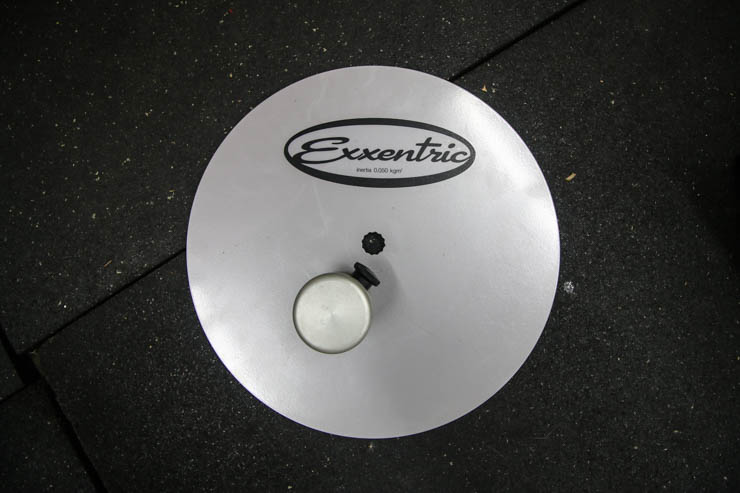
The kBox4 is able to accept up to 4 flywheel discs at a time. This doesn’t sound like a lot, but once you start using the machine, you quickly realize how few flywheels are needed. Each flywheel is measured not by its weight, but the amount of inertia it produces. There are four different flywheel sizes ranging from .010 kgm2 to .070 kgm2. One thing to understand regarding the flywheels though is that just because something produces little inertia, does not mean it’s less ‘difficult’ or has a lessened ‘training effect.’
The higher the inertia, the slower and more controlled the motion will be which forces you to produce a higher force. The lower the inertia, the faster the motion will be causing a higher demand on skill and balance as well as endurance if done for multiple reps. One of the ways I really enjoy using the kBox4 is as a finisher on leg days. Instead of doing my 20 rep squats with a barbell, I’ll strap on the squat harness and do high rep squats with the kBox4, which leads to insane DOMS and a very difficult workout.
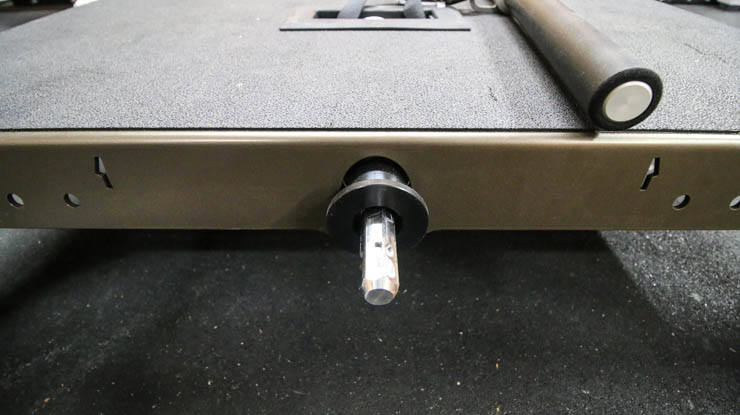
The Exxentric flywheels are made from laser-cut carbon steel that’s been powder-coated. At the center is a star pattern cutout that allows the flywheels to sit flush against the shaft. Due to the importance of the flywheels, these need to be cut with precision so they can sit flat on the shaft and provide consistent revolutions. I store mine in a bag to prevent them from getting chipped, and if you decide to purchase the kBox4, then I suggest you do the same.
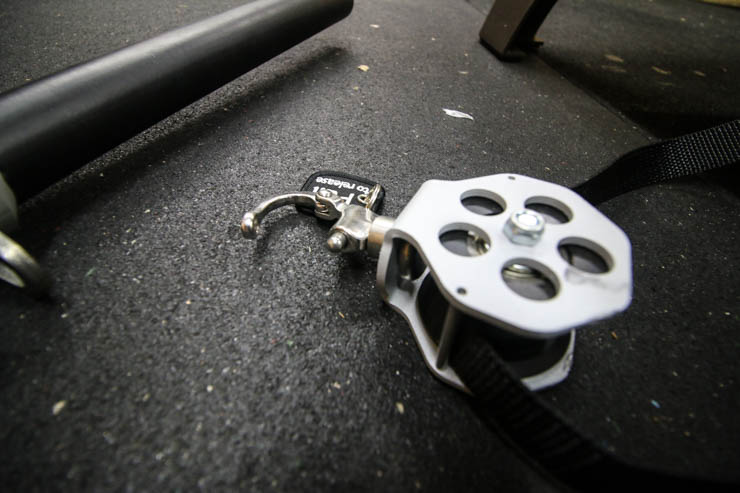
One of the most integral pieces to the kBox4 is the pulley attachment that connects the drive belt to whatever accessory you’re using. From a distance, it looks like a pretty standard carabiner-type system, but in reality it’s function allows the whole system to operate. The drive belt is strapped to the shaft beneath the platform and then routed up around the snap shackle and roller and then back through the platform where an auto-roll system draws the excess cord in by the press of a button on the platform.
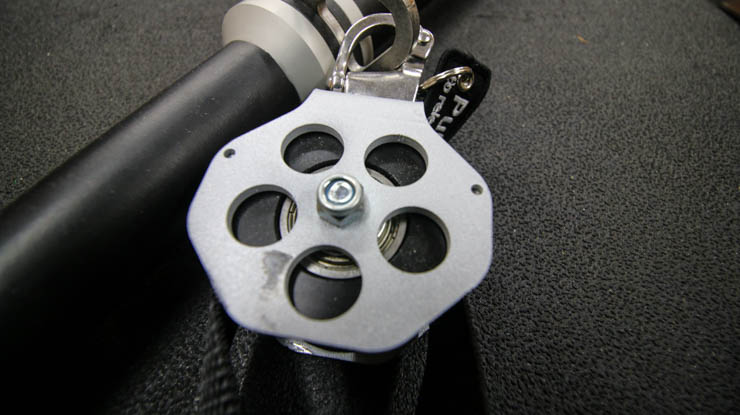
The roller that is beneath the snap-shackle allows the belt to easily slide while you pull against it. Although the way the system is currently configured works great when pulling straight up, I did notice an occasional problem when pulling either too far forward or back. When doing so, the belt would sometimes flip over causing somewhat of a tangle similar to what can happen with seat belts. It was easy to correct the belt after a set, but it was annoyance none the less. I noticed after quite a bit of use, however, that this can be avoided when standing so your toes are facing the short side of the platform.
Now that I’ve gone through the entire system from a build perspective in detail, let me give you my overall thoughts. The Exxentric kBox4 is built not like an exercise machine, but more like a precise engine in which every piece has a purpose and each is done exceedingly well. Although there are a few minor changes I would make in regards to its function, there isn’t much that could make the Exxentric kBox4 more stout, durable, or efficient. The kBox4 is as much a work of art as it is a machine.
In use, the kBox4 is quite versatile. When you first see the kBox4 on social media or elsewhere, you pretty much assume it’s made for squatting.
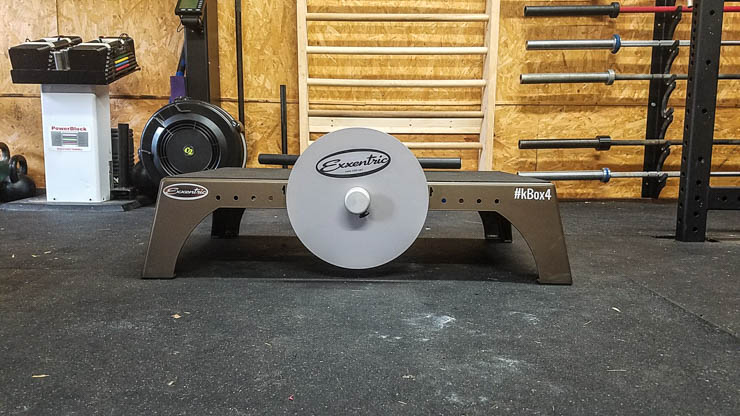
However, although it’s great for squatting, it’s pretty much just as effective for everything else. The movements you can do with the kBox4 is pretty much limited to your imagination (and my imagination still can’t figure out how to use it for bench (if you know, then let me know.)
Flywheel training is unlike any type of training I’ve done before. I’ve been racking my brain trying to come up with things that are most like it, but there isn’t really anything worthy. When doing high reps, it has the same fatigue feeling of widowmaker squats, and the flywheel wants to pull you down continuously like an exercise bike without a freewheel cog.
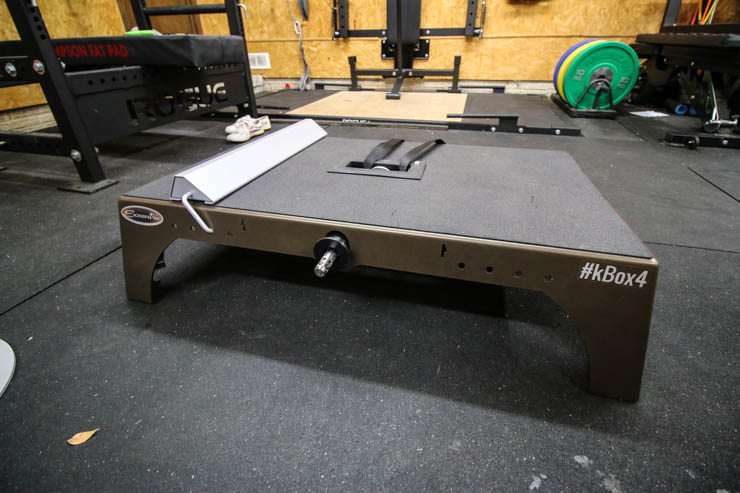
I tried to ask friends who were over for working out to test it out. I gave them a basic idea of how it functions and what to expect and strapped a harness on them and with a pat on the back said, “good luck.” Like sending sheep to slaughter, I laughed as I began spinning the flywheels (of death) to start their first set. The kBox4 is very unassuming and often garners comments like, “it doesn’t look that tough” until they step on the platform.
One of the reasons the kBox4 is so different from what people are used to using is because of the eccentric load that is placed on the user. There’s a seemingly infinite amount of load that could be used as it’s largely dependent on the power of the individual through the concentric portion of the lift to dictate what happens in the eccentric. For instance, when you do a traditional barbell squat, the weight remains the same for the eccentric and concentric portions of the lift (up and down.) With the kBox4, if you come up really hard, it’s going to pull you down really hard and ultimately, you have to prevent the machine from pulling you through the floor.
I’ve used many different pieces of training equipment and this by far the most unique. One way I’ve used the kBox4 that garnered a lot of attention on Instagram was by attaching it to the top of my power rack and using it as a lat pulldown. Due to the way the flywheel is attached to the platform, as long as the flywheel is free to spin, you can pretty much do any movement you could imagine.
One attachment I received with the kBox4 was the Foot Block, a ledge that secures to the top of the platform. This ledge allows you to do one leg lateral work as well as other exercises. In order to make this work, I put the end of the platform I was pushing against, next to the wall. It worked seamlessly and is a perfect example of not only the though that has been put into this machine, but also it’s versatility.
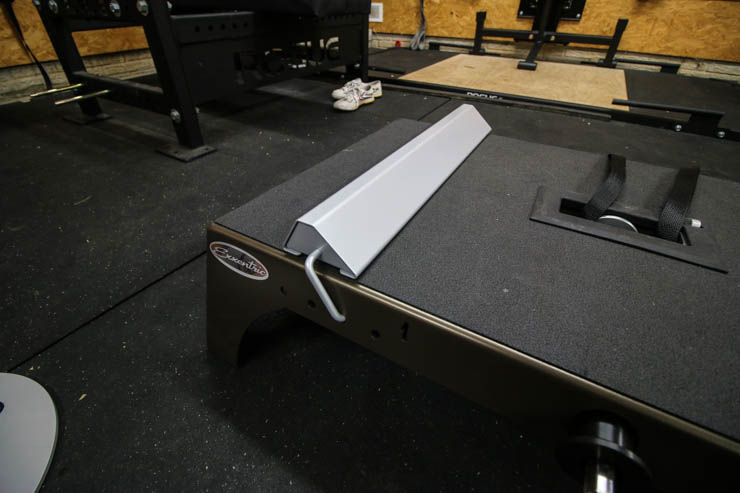
This is somewhat of a bold statement, but I believe someone could get incredibly fit using ONLY the kBox4. Would it be ‘optimal’? Likely not, but I believe that the results could be awe-inspiring as there isn’t a body part that couldn’t be worked.
The craftsmanship, combined with the variety allowed on the kBox4 make it the most innovative piece of equipment I’ve tested in 2017. I am now completely and unashamedly a believer in flywheel training and see Exxentric as the innovators. Although there are other flywheel systems available, the Exxentric kBox4 is the most polished, versatile, and best option available.
Suggested Improvements
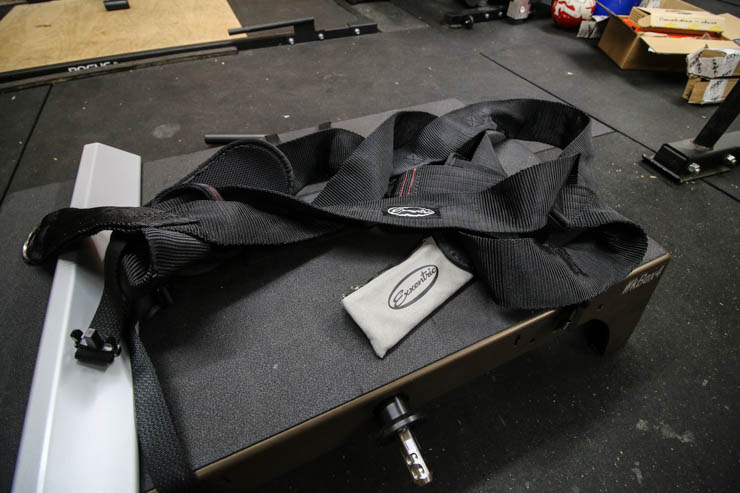
Although we give the Exxentric kBox4 high praise, as always, there are some things that we see could be improved. Before I go into these, I think it’s important to understand that no product is perfect and when doing these honest reviews, we try to be as thorough as possible. As the product currently stands, it vastly exceeded my expectations and is something I’ve already begun recommending to many of our readers. Yes, there are some “improvements” we recommend, but in my day-to-day use of the product, there’s little I would change.
First off, let’s talk about the price. Undoubtedly, the reason for a slower (than I believe it should be) adoption of flywheel training is not a disbelief in its effectiveness (although I’m sure there are detractors) but a difficulty in dropping the amount of money in exchange for the unit. I would absolutely like to see the kBox4 have a price reduction, but as a consumer, I’d pretty much like everything I buy to have a price reduction.
When I first started doing research on the kBox4, I was a pretty skeptical at the price. You look at the unit online and think to yourself, “it’s a platform with a metal wheel.” You then get the unit in your hands and realize not only the amount of effort that went into creating the product, but also the precision and quality of the materials used. This is not a budget-friendly piece of equipment, and it’s not designed to be. This isn’t for the person looking to outfit their gym or training facility the cheapest way possible (unless you only use kBox4’s.)
The kBox4 is for the person who wants a tool that can produce training results that can’t be had using other methods. If you’re a coach or trainer and want the best out of your athletes and clients, then you need to be spending money to not only keep them engaged, but also improving. There’s a reason some of the most popular and successful trainers in the world use the kBox4. Sometimes you have to spend money to make money, and in this instance, making money is increasing performance.
The second improvement I’d like to see is one mentioned in the review, and that is to have adjustable feet. Although I have a flat even surface, I know there are some who don’t, so having adjustable feet would help steady the unit.
The third improvement I’d like to see is a way to attach the kBox to other things. This is a bit out of the box (pun intended) but having some sort of wall attachment to attach the kBox to so you could pull away from the wall or a rack attachment so it could sit securely on the rack would be pretty cool to have as an option. One other idea I had was to have a way for the kBox to clip into a platform that’s secured into concrete. This would keep the user from having to use plates or dumbbells to hold the unit down during simple movements and would also allow the unit to remain portable.
Finally, although the current nylon ribbon that’s used has a high strength rating, it does flip and get twisted every once in a while. If it is possible to use a cord or something that is fine being twisted, I think that would be a cool improvement to see. As previously mentioned, this can be avoided on some movements if you change your stance.
Full Rating
Exxentric KBox4 Flywheel Training
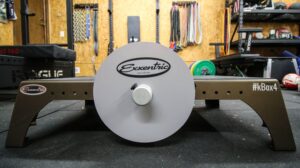
The kBox4 from Exxentric is a revolutionary piece of training equipment that is unlike anything we've tested before. Not only is the flywheel system employed by the kBox4 effective, but the build quality and precision of the machine is unparalleled.
Product Brand: Exxentric
Product Currency: $
Product Price: 1710
Product In-Stock: InStock
4.6
Exxentric KBox4 Flywheel Training FAQs
Are flywheel trainers worth it?
Although motorized resistance is currently relatively expensive, it does give actual eccentric overload, as well as a superior user experience and training possibilities. Flywheels will be around for a long time because they don’t need much effort to operate and are a fixture in many training regimens.
What is flywheel inertial training?
Flywheel training is a type of strength training that, unlike traditional gravity-based resistance training, allows you to execute workouts with eccentric overload and variable resistance.
How do I use kBox Exxentric?
Place both feet on the kBox and wear shoes at all times. Remove the belt from the shaft and unwind it. Hold the belt release button down while positioning the pulley block in the appropriate top position and wait for the surplus belt to be rewound automatically.
What is kBox flywheel?
The kBox is a line of high-end flywheel training gadgets backed by scientific evidence. The kBox4 Active, kBox4 Lite, and kBox4 Pro are the three variants available in the newest iteration of the kBox.
Where to Purchase
Exxentric

The kBox4 Pro is set apart by its market leading maximum inertia, built-in kMeter II feedback system and larger surface area, loved by strength and conditioning coaches as well as physiotherapists and top level personal trainers.The kBox4 Pro Platform is made in Sweden from powder-coated aluminium, with details made of anodized hardened carbon steel and aluminium, and high-friction rubber. This model has a CE-marking Certificate as a Medical Device. The kBox4 Pro can simultaneously hold four Flywheels of up to 0.070 kgm² each, with the maximum inertia level being 0.280 kgm².With the kBox and kPulley, instead of a fixed load determined by gravity when lifting weights, you work against the variable inertia of heavy steel flywheels determined by the effort and energy you unleash into the device.These training devices are truly versatile and serve multiple purposes, allowing you to engage your upper body, core and lower body with a wide variety of exercises.The kBox is renowned for its genial application of eccentric overload in regular training as well as its variable resistance, both backed by growing scientific support.
Further reading

We researched and tested equipment, programs, and supplements across the industry to find the very best of the best. Find out what we think is hot this year. Read more

The fitness experts at GGR have compiled the 9 best cable leg exercises for your next leg day! Read on for the benefits and sample cable leg workouts. Read more

Steam Room vs Sauna Read more

Not sure how to clean a barbell? This guide will help you knock the rust off. Read more

